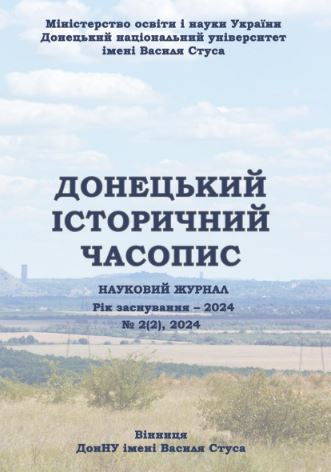The Bykivnia dimension of Donechchyna
DOI:
https://doi.org/10.31558/3083-5771.2024.2.6Keywords:
political repression, burial place, Bykivnian forest, natives, Donetsk region, 1937–1938Abstract
The purpose of this study, based on archival and criminal cases of the repressed, is to single out and analyze the main forms and specifics of political repression against the natives of Donetsk during the period of the «Great Terror» of 1937–1938, who achieved professional and career achievements and fully supported the Soviet government, but were repressed for falsified accusations and secretly buried on the territory of the NKVD special precinct in the Bykivnyansky forest. Research methodology using a paradigmatic approach is based on the principles of objectivity, systematicity, historicism, dialectics and interdisciplinary. Which allows applying both historical and historical-pedagogical methods (contentanalysis, metabiographical). The logic of the presentation of the research material is based on the problem-historical principle. The scientific novelty of the research is related to the fact that the issue of analyzing archival and criminal cases of natives of Donetsk region, buried on the territory of the former special area of the NKVD in the Bykivnian Forest in the context of studying the mechanisms of mass political repressions of 1937–1938 is understudied and topical and requires further research.
The conclusions of the study, which is based on the materials of archival and criminal cases of the natives of Donetsk region, show us the phenomena when the NKVD authorities not only falsified accusations and evidence, but also «multiplied» and scaled these counterrevolutionary Trotskyist organizations, promoting the rampant Soviet terror of 1937–1938. At the same time, the analysis of the materials of the cited archival criminal cases shows us the various multifaceted methods of the Soviet executioners against the Ukrainian people, even against those who faithfully served and served them, regardless of their merits to the country, to the party, which mercilessly destroyed them
References
Ammons, A. (2017). Masovi pokhovannia zhertv politychnykh represii 1937–1941 rr. v Ukraini: problemy identyfikatsii ta doslidzhennia [Mass burials of victims of political repressions of 1937–1941 in Ukraine: problems of identification and research]. Bykivnianska trahediia v konteksti zlochyniv totalitarnoho rezhymu (do 15-richchia zasnuvannia Natsionalnoho istoryko-memorialnoho zapovidnyka «Bykivnianski mohy-ly»): Zbirnyk statey̆ za materialamy naukovo-praktychnoï konferentsiï, m. Kyïv, 8 hrudnia 2016 r. (2017) / Uporiad.: B. Biliashivskyy̆, T. Sheptytska. Kyiv: b. v., 199–222 [in Ukrainian].
Derzhavnyi arkhiv mista Kyieva [State Archive of the City of Kyiv] [in Ukrainian].
Haluzevyi derzhavnyi arkhiv SBU [Sectoral State Archive of the Security Service of Ukraine] [in Russian].
Kyselov, S. (1988, 30 lystopada). Tay̆na Bykovnianskoho lesa [The secret of the Bykivnia forest]. Literaturna hazeta, (48), 2 [in Russian].
Shliakhom morduvan [By making faces] (1941, 8 zhovtnia). Ukrainske slovo. (25), 2 [in Ukrainian].
Zvirstva enkavedystiv u Kyievi. Vykryly mohyly pomordovanykh liudei (Za voiennym korespondentom A. P. Kolmusom) [Atrocities of Enkavedists in Kyiv. The graves of the murdered people were uncovered (according to the war correspondent A. P. Kolmus)]. (1941, 4 zhovtnia). Lvivski visti, (49), 3 [in Ukrainian].

